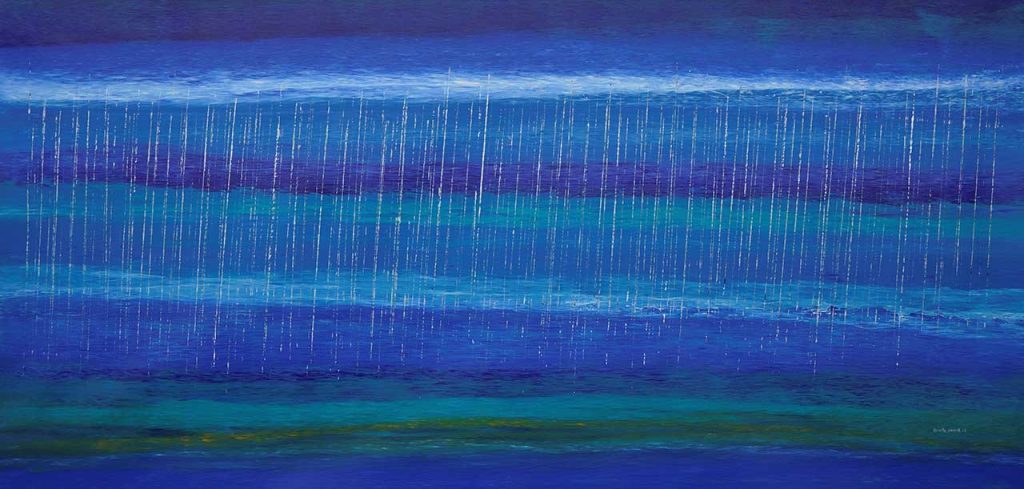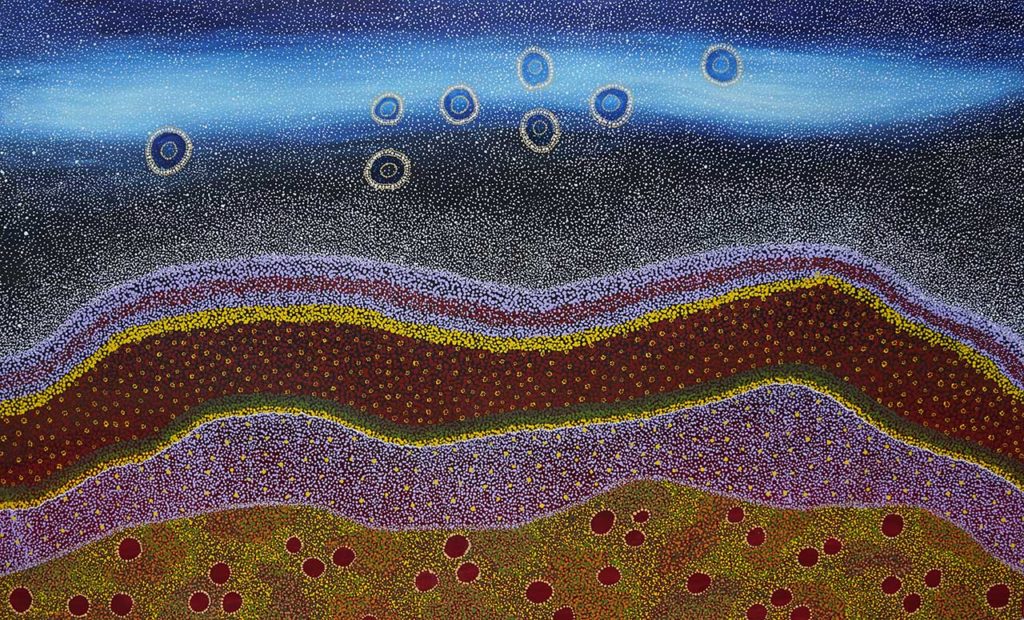Here’s A Couple of Our Personal Favourites
In this article Japingka's Ian Plunkett shows us a couple of his favourite works from the gallery collection. He discusses why these works have such a special appeal for him.

Rosella Namok is one of my favourite artists, and her work is not what you might expect from an Indigenous artist. Her paintings are crossover paintings in a way. They are traditional landscapes or seascapes, but with a twist. They are painted from the perspective of an Indigenous person who clearly knows and understands the environment inside out.
I find her paintings immensely evocative, and they really speak to me. This painting is about looking out to sea in the afternoon. It is set in the tropics because Rosella divides her time between Cairns and Lockhart River in far North Queensland. You can see the tropical rains in the afternoon, coming down, hitting the sea. It is overcast and moody, and it is easy to imagine being there. You can almost feel the humidity emanating from the canvas.
The rain you can see is what Rosella calls stinging rain. It's pelting down. You can see it hitting the sea and the waves as they roll in. You can imagine being there, on the beach, probably getting drenched. You are looking at the different blues and greens of the sea, as you gaze out right out to the horizon. It's hard to tell where the sea becomes the sky and this rain coming down is diffusing everything and cooling everything down.
If you've ever been to the tropics, you're very aware of the afternoon storms that pass over. Everyone looks forward to the rain because it cools things down. The humidity can be quite crippling in far North Australia.
Rosella almost always paints things to do with family or her country. In this case, its one of her favourite topics - looking out to sea. Rosella is part of a group of artists euphemistically called the Lockhart River Gang. There are three major women artists who formed a group. They each have their own distinctive styles, but they all reflect on the Lockhart River region.
Fiona Omeenyo's paintings are more about the importance of clan and family and doing things together. They tend to be more figurative. Whereas Rosella's are almost uniquely all landscapes and natural elements. Sometimes she paints the reflections of the moon over a billabong. You can just see the waves rippling through the reflection.
Everything she paints is so well-informed, and so insightful that her paintings lift any space in which they are hung. They have a slight edge to them. They're not pretty landscapes. They're not a chocolate box, but they're very real with a sense of honesty and a passion. That's why her paintings speak to me.

Sonya Edney is a very exciting artist from the Gascoyne region and her country also includes Mount Augustus. That massive rock is the world's largest 'monocline' - twice the size of Uluru. It's 850 km north of Perth, 490 km east of Carnarvon, and is about 1.6 billion years old.
As well as its ancient geography, Sonya's country is also famous for its wildflowers and these feature in her work. She also paints the night sky which is vivid and stunning in such a remote place. Most Indigenous paintings are painted from the perspective of an ariel view. You're looking down on the land, seeing all the stories associated with the land and all the rivers and people and traditional stories. However Sonya is part of a small group of artists who paint looking up into the sky, and in particular the night sky. Sonya is one of the best proponents of this.
She often paints the Milky Way and Yalibirri the Emu in the Sky. This is one of those formations you see as part of the Milky Way, especially in the Southern Hemisphere. It takes the form and shape of an emu.
The other story that Sonya paints is the ancient Seven Sisters Dreaming story. You'll find this story goes right across Australia. Sonya paints that from the perspective of her country, looking up from the sky from around Mount Augustus. She's included the Pleiades Star cluster, and one of the stars from Orion's Belt, which makes up the eighth star. It's an ancient story of forbidden love. What I like about the story is that it's a unifying story that Aboriginal people from the east coast to the west coast of Australia.
Most of the other traditional Aboriginal stories are very regional or belong to a very small number of tribes. The Seven Sisters story is universal. Sonya paints not only the night sky, but she includes in it the landscape as well. You've can also see all the wildflowers coming into season. You've can see the stars of the Pleiades Cluster, and in the background, you've got the myriad of stars that make up the Milky Way.
There is the band of blue that goes through the top part of the painting, which is the central part, the Emu part of the Milky Way. Sonya came to Japingka Gallery because she wanted to develop her career. She wanted to have a solo exhibition and we immediately recognised her unique talent.
We were very honoured that she approached us and we were able to mount her first solo exhibition last year. We'll be having a brand new exhibition of works by Sonya in 2021. Her work has been an amazing success. It has been embraced all around the world. We've sent paintings to the United States, Europe, Asia, and everyone seems to relate to her paintings. These works are created from an innate skill and knowledge of her country. They are joyful celebrations of ties to the land. It's been a real honour representing Sonya. We're looking forward to the exhibition next year, which should be a real show stopper.
We understand that two of Sonya's works will be on permanent display at the new Western Australian Museum. We are thrilled to hear this news and look forward to seeing these works displayed as part of the museum collection.
If you'd like to find out more about these artists just follow the links below. Both of the artworks featured here are currently on display on the ground floor of Japingka Gallery and you are welcome to drop by and see why we are so impressed with them.
